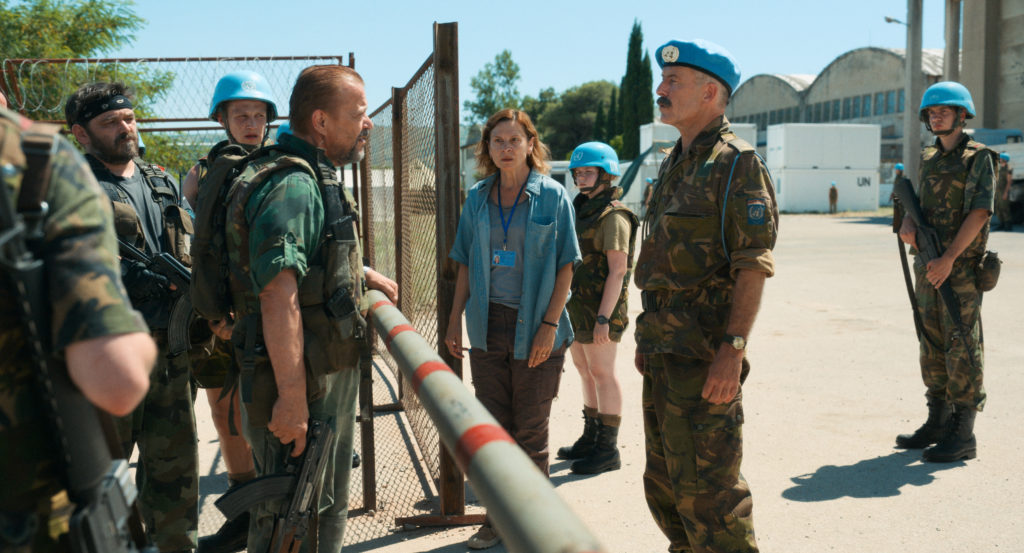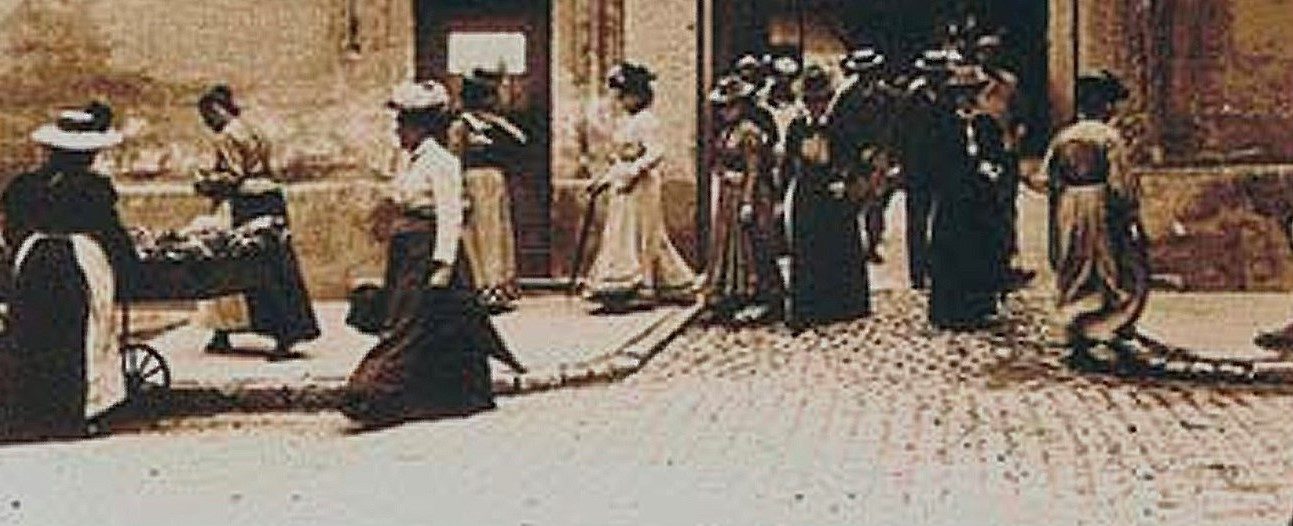Bosnia and Herzegovina, Austria, Romania, Netherlands, Germany, Poland, France, Turkey, Norway, 2020
Directed by Jasmina Zbanic
With Jasna Djuricic (Aida Selmanagic), Izudin Bajrovic (Nihad Selmanagic), Boris Ler (Hamdija Selmanagic), Dino Bajrovic (Sejo Selmanagic), Johan Heldenbergh (Colonel Karremans), Raymond Thiry (Major Franken), Boris Isakovic (General Ratko Mladic)

Close-ups and extreme close-ups highlight the tension running through the faces of the people sit around the table, intently listening to a radio broadcast. Shot and reverse shots and medium shots show how this tension explodes into a bitter confrontation between two groups of men, on the one side civilians from Srebrenica and on the other side soldiers from the United Nations (coming from the Netherlands). Sitting in the middle, chain-smoking as nervously as others around her, her face displaying weariness and stress, a woman translates increasingly curt and testy exchanges in English and Serbo-Croatian, struggling to make the words clearly heard. Not everyone shakes hand at the end of the meeting: the loss of trust is obvious, even more is the feeling these officials are losing control what is going on.
The region of Srebrenica, in eastern Bosnia and Herzegovina, was a flash point as soon as the civil war in this part of the former Yugoslavia broke out in April 1992. People fled villages under attack, and the town was quickly filled with huge numbers of refugees even as Serbian forces were besieging and bombarding it. In April 1993 Srebrenica was chosen as one of the safe havens the United Nations vowed to set up across Bosnia and Herzegovina to protect civilians against further military aggression and provide relief. Special UN peacekeeping forces were supposed to keep fighters at bay.
But in March 1995 the civilian and military leaders of the Serb Republic, proclaimed at the start of the civil war and carved up from the territory of Bosnia and Herzegovina after horrible fighting, decided it was time to claim the town and to make it truly Serb – that is, to eliminate the whole Muslim population, the policy known as ethnic cleansing. The operation started in the first days of July: this is when the film begins. It is plain to the town officials that the Serbs are going to invade and that the ultimatum of the UN would not be enforced – no one is going to drop bombs on the armored vehicles and tanks led by General Ratko Mladic, despite the claims of Colonel Karremans, the UN military commander for the safe haven.
The bloody conquest of the town is dealt with a few shocking shots, enough to suggest the heavy price paid by the inhabitants, but refraining from long, graphic, poignant descriptions that a war movie could offer. The camera is rather trained on Ratko Mladic, showing a tough military leader remarkably self-conscious of his image and propaganda – he is always trailed by a cameraman, and would be all along the story. The film thus points out the tragedy cannot be just grasped as a war event and an outrage, with the horrific imagery it stokes: the real horror stems from the fact it fits into an assertive, self-fulfilling political narrative exalting a man and an ideology, and that the events occur because they were outlined in the narrative.
The tragedy’s epicenter moves fast from the town and to the vicinity, in the UN compound where people seek to shelter – but only a fraction of the population can make it behind the guarded gates, and only to find themselves in appalling conditions; the rest waits outside, in sun baked fields. All wonder what the Serbs, who have set up in the empty town, are up to.
The interpreter, Aida Selmanagic, because of her UN job and because she wants to rescue her family, is the link between the inside and the outside, bearing witness to the growing powerlessness of the UN troops and the cunning pressure of the Serb separatists. The drama she creates, that is her relentless, fierce drive to put her husband Nihad and their sons Hamdija and Sejo out of harm’s way, first pleading successfully to let them in the compound and later trying unsuccessfully to get them on UN vehicles as UN aides, is truly relatable, definitely heartbreaking, sustaining the audience’s interest and emotion. And through twists full of suspense and tension, like the meeting between Ratko Mladic, his aides, the Dutch officers, and three representatives of the Srebrenica refugees including Nihad Selmanagic, or Aida’s mad rush in the corridors to get the documents and authorizations to present falsely her relatives as part of the UN staff, a poignant and stunning race against time and against the rules doomed to fail, this drama also delves into the failures of the UN and the cynical, callous, and calculated moves of the Serbs.
The picture is depressing: Ratko Mladic is a master of manipulation, deception, and absolute, cold-blooded, efficient determination, while on the other side, the Dutch troops are hopelessly overwhelmed by the humanitarian disaster, the Serb pressure, and above all the utter lack of means and political support – they just cannot do anything serious to accomplish their mission. If Aida’s plight is often shot with frenzy, the camera favoring close-ups and shallow focus, the political disaster is handled with wider shots, and composed carefully, emphasizing the sly paternalism of Ratko Mladic – the moments when his machine gun-toting troops quietly hand out bread and later chocolate bars – and the pathetic mayhem of the UN organization – the phone call cut short, the mess and dirt left on the floors by the refugees invited to get on the Serb buses ready to take them to places that would not be always safe.
Some 8,000 men and male teenagers were massacred. A few shots, for instance on a shaken and exhausted bus driver, suggest, as the events proceed despite the anger, disgust, and some futile efforts of Colonel Karremans, his deputy Major Franken, and their young men, that the worst is to come. It does come for Nihad Selmanagic, Hamdija Selmanagic, and Sejo Selmanagic, and others, in a building in the town. Death is not shot – once again, the film does not try to be overly graphic and emotional. It is still chilling, as the wide shots and tracking moves point to the ordinary life blooming around the massacre, the scandalous image of a population willfully and blissfully oblivious of their former neighbors’ deaths.
The image fades in bright white, which cuts into a long shot on a snow-covered landscape where a car is winding: the film is not over. Some year after the genocide, Aida Selmanagic comes back to the town, claims back her apartment (which has been rented by one of Ratko Mladic’s deputies), and resumes her job as an English teacher. She is a broken woman, older and despondent, still trying to come to terms with her loss, and like others trying to find the remains of her murdered relatives. She manages to achieve the latter goal, in a sober, heartbreaking scene. And it could be that she manages the former, as the film ends with the kind of show put up by the pupils and their teachers to mark the end of the school year. As the camera surveys the folks attending the show, faces from the tragedy appear, conveying another kind of tension; and then the camera settles on Aida Selmanagic and a tracking shot captures her smile, ending with a close-up at the opposite of the first image of the lead character. The coda copes with the difficult coexistence in the town of those who killed and those who suffered, suggesting a sense of closure and a modicum of respect is still possible – the film has moved from a thorough, painful investigation of a genocide carried out a generation ago in the name of a flawed narrative to the possibility another narrative may arise from the present.
This is a brave and sober work of art, if only because the wounds of the civil war are still raw, and part of the news. It is released as a judgment confirmed, in July 2021, the verdict and sentence delivered by another court in 2017, recognizing Ratko Mladic guilty of war crimes, crimes against humanity, and genocide in the town of Srebrenica, and as political paralysis still grips the young, federal state of Bosnia and Herzegovina. It has been shot in a town that is still a flash point of ethnic hatred, Mostar. It took a lot of foreign partners to fund it. But here it is, the first time the genocide is the topic of a fiction film, and dealt with from a local perspective, as the director was born in Sarajevo, in 1974 – and for Jasmina Zbanic, it is a remarkable achievement for what is just her fifth feature.
The title she chose brings in mind a famous book, but rather awkwardly as the texts of Polish writer Henryk Sienkiewicz are often tinged with the kind of nationalist passion that wreaked havoc in the Balkans. Actually, the Latin “Quo vadis” phrase, “Where do you go?” comes from a tale from the apocryphal “Acts of Peter”, an encounter between the Apostle and Jesus. Falling down in adoration he asks Him the question, and Jesus replies to him, “I am coming to Rome to be again crucified.” Peter says to Him, “Lord, wilt Thou again be crucified?”, and Jesus says to him, “Even so, I will again be crucified.” Peter says to Him, “Lord, I will return and will follow Thee.” And with these words the Lord ascends into Heaven. It could mean that Peter is given the opportunity to reflect on his own passion, which the Lord would suffer. So the Apostle can return to his task, even if he then meets death, because he is reassured and relieved that the Lord wants him to die for the faith. Aida Selmanagic, however, does not die: returning home means to her a struggle not to forget but also to carry on. She scurried the UN compound to get solutions, and grief was the only reward. The titular question was then pressing, and the answer tragic; now, it points to the hope that justice and peace are just a few steps away.

